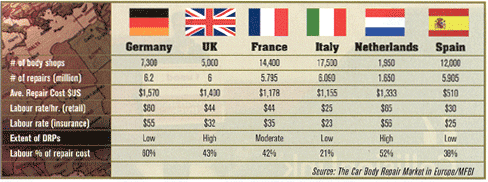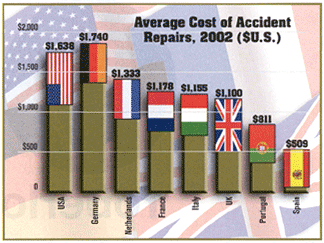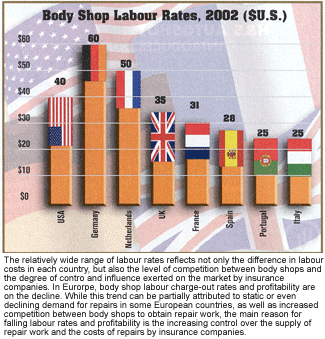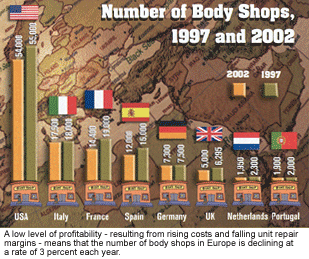While repairers in the mature economies of Western Europe struggle with static (or falling) repair rates, rising repair costs and insurer interference, collision repair in the less-developed economies of Eastern Europe is becoming a growth market – making it profitable to be a repairer … for now.
The continent of Europe comprises nearly 40 separate countries that, when combined, represent a trading block and market area similar in size to the United States. At the heart of Europe is the European Union (EU), an economic and political confederation of 15 countries or Member States, which is to be expanded to 25 Member States in 2004. Western Europe – which includes the countries of Germany, Italy, France, Spain, Portugal, the Netherlands and the United Kingdom – has a car parc similar in size to the whole of North America including Canada, at nearly 200 million passenger cars. This represents a large potential market for collision repair with approximately 35 million repairs carried out each year.
That being said, let’s examine the trends in Europe and how they compare with the United States, the largest single collision repair market in the world.
Market Overview
Globally, the prospects for the collision repair market depend mainly on the demand for collision repairs and the degree of control and influence that insurance companies and car manufacturers have over the market. In mature, developed economies such as those of North America, Western Europe and Japan (which are experiencing low birth rates and low population growth), even though vehicle ownership continues to rise as greater affluence results in multiple car-owning households, accident rates and repair rates are static and in some countries are falling. This is because even though the number of car drivers within a country’s population may be on the rise, decreasing average mileage driven per car and increasing vehicle congestion and vehicle technology mean that collision repair is experiencing a decline in demand.
However, a decline in demand in terms of repair volume is being offset by increases in average repair costs, as cars become more technically complex. Mature economies with a high and increasing proportion of older people within their population and an increase in the number of business and company cars are resulting in a shift away from basic cars to high specification cars and niche vehicles targeted at different lifestyle and lifestage segments. This results in higher-cost OEM replacement parts being used in accident repairs and rising repair costs. This means that for insurance companies, even though the number of accident claims may be static or falling, the cost of claims is still rising, which is compounded by an increasing number of higher-cost personal injury claims.
To try and control repair costs, insurance companies are encouraging policyholders to use nominated body shops with which they have agreements, including discounted labour costs, paint and parts prices. Many policyholders and body shops are resisting this because in many countries in Europe (except the UK and the Netherlands), a high proportion of repair costs is paid direct to the policyholder and not to the body shop before the car is repaired. Policyholders in some countries are entitled to decide not to have the car repaired and simply keep the payment of repair costs for themselves or find a body shop that will perform the repairs for a lower cost. In the UK and the Netherlands, insurance companies are successful in nominating body shops for repairs because of extensive direct- repair programme networks.
In regions such as South America, Eastern Europe and Asia, which are experiencing a growth in population and rising incomes as production and some global service industries move away from high-cost economies in the Northern and Western hemisphere to lower-cost economies in the Eastern and Southern hemisphere, car ownership and car usage are rising – and so is the number of collision repairs and body shops. In these regions, collision repair is becoming a growth market with an increase in volume demand and higher repair costs. Whereas in the mature Western economies where the proportion of repair costs accounted for by labour is falling thanks to higher parts prices, larger body shops, falling repair times and more labour- efficient repair methods, in South America, Eastern Europe and Asia, rising demand, increasing technical skill levels and rising wages means that the labour component of repair costs is rising. This trend is having a beneficial effect on body shop profitability in these regions.
There are, however, exceptions to this generalisation with individual countries within a region or individual states within a country experiencing a faster rate of economic development than the average for the region or country as a whole. Spain is a typical example in Western Europe of a relatively large country where average wages and GDP are below those of other Member States of the European Union. Its collision repair market also differs from other countries in Europe in that it’s experiencing rising demand for collision repairs but much lower average repair costs.
In developing or less affluent economies, there tends to be a high penetration of basic third-party motor liability cover, which means that a high proportion of car owners is liable for their own repair costs. This tends to result in smaller repairs of lower average cost. As incomes and affluence in Spain catch up with the rest of Europe, car ownership and car usage are increasing, and the penetration of own-damage insurance is also rising. Spain is therefore a growth market within an otherwise mature and static collision repair market in Western Europe.

Examining Europe’s Big 3 Markets
- Germany is the largest economy in Europe, with high levels of car ownership and a high level of third-party liability coverage. Repair costs are often paid directly to the policyholder rather than to the body shop before the car is repaired, and a policyholder can legitimately keep the payment and not have the car repaired. DRPs are not well-developed in Germany, and insurance companies have little direct control over repair costs and over which body shops carry out insurance repairs. Germany also has a static collision repair market but very high labour rates. There’s also a high level of sub-contraction of repair work by franchised dealers to independent body shops and paint shops.
- The United Kingdom is the second largest economy in Europe and also has high levels of car ownership – but with a high penetration of own damage or comprehensive motor insurance cover. Insurance companies therefore pay for 80 percent of all collision repairs in the UK and have a strong hold over the collision repair market through extensive DRP networks. This means that approximately 50 percent of all repairs are carried out at body shops nominated by insurance companies. The collision repair market in the UK is probably the least profitable repair market in Europe for body shops because of high levels of service demanded by insurance companies. Free courtesy cars, free collection and delivery of customers cars, discounts on labour, discounts on parts and discounts on paint are all now well-established in the UK. This has depleted body shop profitability in the UK and the number of body shops has fallen 30 percent in the last 10 years.
- France is the third largest economy in Europe with a similar size population and level of car ownership as the UK, with a similar number of repairs carried out each year at around 6 million. France’s population is less concentrated in major cities so there are a large number of body shops in smaller rural towns and villages, totalling more than 14,000 compared with just 5,000 in the UK. France is another country with a high level of third-party liability insurance coverage and where policyholders decide for themselves where to have a car repaired. As in Germany, there’s also a high proportion of direct payment of repairs to policyholders rather than body shops before a car is repaired. A proportion of these direct payments is kept by policyholders rather than used to pay for a car to be repaired.
Average Repair Costs
If we look at the major repair markets in Western Europe, average repair costs differ quite markedly, ranging from $509 in Spain to $1,740 in Germany. By comparison, average repair costs in the United States are $1,638. The wide disparity in repair costs is caused by several factors, including the cost of replacement parts used in repairs, the cost of paint and materials used in each country, and the age and make of the cars repaired in each country.
National car manufacturers still account for a high proportion of their own country’s car parc, which will be reflected in the type of cars repaired and their repair cost. A high proportion of repairs in France, for instance, will be accounted for by French car makes – similarly, German makes in Germany and Italian makes in Italy. But one of the main factors affecting repair costs is the difference in labour charge-out rates in each country.

Labour Charge-Out Rates
Body shop labour charge-out rates per hour for accident repairs range from a low of $25 in Italy and Portugal to a high of $50 and $60 in the Netherlands and Germany respectively. This compares with an average labour rate in the United States of $40 per hour. The relatively wide range of labour rates reflects not only the difference in labour costs in each country, but also the level of competition between body shops and the degree of control and influence exerted on the market by insurance companies. The main reason for the much higher labour rates in the Netherlands and Germany is that these countries have very high social employment costs, which is reflected in the labour rate. In Germany in particular, insurance companies have (as of yet) exerted very little control and influence over body shops and repair costs. Car insurance also tends to be higher in Germany, which is reflected by the labour rate.

Growing Insurer Control
In the major countries of Western Europe including Germany, Italy, France, the UK, Spain and the Netherlands, insurance companies are actively seeking to secure greater control over the collision repair market. The reason for this is that motor insurance is a relatively unprofitable class of insurance, with the cost of claims roughly corresponding to premium income. Although income from invested premiums can offset underwriting losses from motor insurance, the downturn in world stock markets has seen the return on invested premiums plummet.
In Europe, motor liability (third party) insurance coverage is compulsory for all car owners, and until Europe’s insurance markets were deregulated in 1994, the majority of cars were insured with just third-party coverage. So when car owners without any additional own-damage or comprehensive insurance coverage were the at-fault party in a collision, they were liable for paying for the repairs to their own car. In some countries, such as the UK, around 85 percent of cars are now covered by own-damage or comprehensive insurance. But in Italy, for example, own-damage coverage still accounts for less than 20 percent of all motor insurance coverage. This means that in the UK and in other countries where there’s a high penetration of own-damage insurance coverage, insurance companies finance most of the repairs in the market. But in countries such as Italy, private motorists still pay for a high proportion of repairs themselves.
Throughout Europe, car owners are free to choose where to have their car repaired. It’s regarded as being a restrictive practice if an insurance company tries to force a policyholder to use a particular body shop.
If a car is under four years old, the car owner is more likely to take it back to the franchised dealer from where the car was bought or where it’s currently serviced. Less than 40 percent of franchised dealers in Europe (in some countries, it’s less than 10 percent) operate their own body shops, resulting in a high proportion of repairs being sub-contracted by car dealers to independent body shops. For insurance companies, sub-contracted work results in inflated repair costs because the car dealer will invoice the insurance company for the repair costs, including the dealer’s own margin on the body shop’s labour cost, plus the cost of the OEM parts used in the repair. Insurance companies throughout Europe want to avoid these on-costs and are therefore developing DRPs of approved body shops.
Direct-Repair Programmes
In some countries such as the UK and the Netherlands, DRPs are more developed and insurance companies are able to direct between 50 percent and 75 percent of all repair work to their DRP networks. In other countries such as Germany, France and Italy, insurance companies have yet to establish DRPs of any significant size.
In addition to the DRP networks of insurance companies, there are also DRPs operated by large fleet- and accident-management companies. In countries such as the UK – where 50 percent of all new cars each year are bought by companies – fleet-management companies provide a maintenance and repair management service to large fleet operating companies by recruiting service workshops and body shops as approved maintenance and repair outlets. These repair and maintenance networks are also marketed to insurance companies that may be too small to operate DRP networks of their own.
The main catalyst for the development of DRPs in countries such as the UK and the Netherlands has been the consolidation of the insurance industry, plus the need to control repair costs. The deregulation of insurance and financial services markets in Europe in the early 1990s resulted in the start of a process of mergers and takeovers between insurance companies. This has resulted in a much smaller number of more powerful insurance groups with operations in countries across Europe and with larger shares of the insurance market. This means that an insurance company that’s increased its share of the motor insurance market in a particular country – from say 8 percent to 15 percent – has control over a much larger number of repair claims. This potentially enables the insurance company to offer a much larger volume of repairs to a network of body shops in return for repair cost savings.
Reduced Labour Rates
For body shops, being a member of an insurance company’s or a fleet company’s DRP network is meant to provide an almost guaranteed supply of work. The downside is that as insurance companies have become larger in Europe, they’ve forced body shops to reduce labour rates in return for providing a higher volume of repairs. But lower real labour rates demanded by insurance companies haven’t been the only problem for body shops. Insurance companies are also demanding higher service levels. Free courtesy cars for every customer plus free collection and delivery of a customer’s car before and after repair are becoming increasingly common features of insurance company repair contracts across Europe.
For body shops, higher service levels are resulting in an escalation of overhead costs. In the UK, some body shops are operating on a productive-to-administrative staff ratio of 1:1. As higher service levels and lower labour rates spread throughout Europe, profitability is being squeezed – both by an increase in operating costs and by a reduction in hourly labour charge-out rates. The situation has become so bad in the UK that body shops are now unable to meet their prime operating costs from their labour sales. Most UK body shops are now solely dependent on the profit margins from the sale of paint and parts used in repairs for their overall profitability.
Shrinking Repair Times
Another feature of the collision repair market in Europe is the shrinkage of repair times thanks principally to the introduction of computerised estimating systems. Many body shops in Europe are finding that the times allowed for particular standard repair tasks as specified by computerised estimating systems are lower today than a few years ago. Throughout Europe, the basis for computerised systems are car manufacturer repair times. Even though insurance companies in some countries have developed their own repair times databases, insurance companies have generally accepted car manufacturer repair times because of their depth of coverage and completeness.
For the car manufacturers, a car’s insurance rating is an important factor in determining a car’s operating cost and its ultimate saleability. With high and rising insurance premiums in Europe, car manufacturers try to obtain low insurance ratings for their models, and a key factor in determining this is a car’s repair cost. Car manufacturers in Europe obtain most of their profitability from the sale of replacement parts rather than from the sale of the car itself, and the cost of replacement parts accounts for approximately 50 percent of average repair costs in Europe compared with 37 percent in the United States. The costs and margins of OEM replacement parts in Europe are high, so to protect their profitability from high replacement parts prices while at the same time trying to minimise the repair cost of their models, car manufacturers have been reducing the labour cost of repairing their cars by reducing the repair times.
The labour profitability of repairs isn’t of direct importance to car manufacturers other than the overall impact this has on the profitability of their dealer networks. For car insurance companies, however, repair times and labour costs are particularly important. In some countries, a large number of body shops are still compiling repair estimates using their own opinion or experience times. This means insurance companies have to employ large fieldforces of assessors to check and, if necessary, negotiate down a body shop’s repair cost estimate. This results in higher claims administration costs for insurance companies. Consequently, if a higher proportion of repair estimates is produced using standard repair times generated by computerised estimating systems, insurance companies gain greater control over repair costs because of a reduction in body shop opinion times.
Computerised estimating systems based on car manufacturer repair times are, therefore, becoming a standard requirement within insurance company DRPs. For body shops, the added investment cost of adopting computerised estimating systems – the cost of which has to be met from a declining labour rate – is yet another cost burden. This is then compounded by the fact that the repair times allowed for many repair tasks generated by computerised systems, based on manufacturer repair times, are falling. For body shops, this also means that not only is the profitability of their labour sales declining thanks to demands from insurance companies for lower labour rates, the number of labour hours they’re able to sell to insurance companies is diminishing because of the adoption of computerised estimating systems and manufacturer repair times.

Declining Body Shop Numbers
The overall impact of increasing insurer control over collision repairs and car manufacturer control of repair times is that body shop profitability is falling across Europe. In the United States, average body shop return on net turnover is between 5 and 10 percent. In Europe, it’s between 2 and 5 percent. This low level of profitability as a result of rising costs and falling unit repair margins means that the number of body shops in Europe is declining at a rate of 3 percent each year. As body shops compete with each other to secure a larger volume of work from a smaller number of larger insurance companies, body shops in Europe are gradually increasing in size. This results in an increase in overall repair capacity in each country, leading to an excess of capacity overdemand, which is further compounded by static or falling repair demand.
In Europe, the development of DRPs means that a higher proportion of repairs is being concentrated within a smaller number of body shops. For insurance companies, this is good news in the short term because it means that body shops will be prepared to offer discounted labour rates and higher service levels to insurance companies in order to obtain work and remain in business. In the longer term, however, the concentration of repairs among a smaller number of larger body shops and a decline in the number of body shop outlets will potentially become a threat. This is because the number of body shops will decline to a level where repair capacity is in equilibrium with demand. When this happens, body shops will increase their labour rates as demand levels with or exceeds repair capacity.
In the UK where the decline in body shops has been occurring over the last 10 years, there are signs that repair capacity has fallen to a level equivalent to repair demand. Whereas body shops in the UK were prepared to sign up to insurance DRP contracts at labour rates as low as $25 per hour, today there are signs that insurance companies are being turned away by shops unless they’re prepared to pay higher labour rates.
The UK model of how the collision repair market has developed isn’t a good model for the rest of Europe nor for the United States to follow because the decline in body shop numbers and total market repair capacity is now becoming a problem for insurance companies – and has put a lot of shops out of business in the process. In a global market where returns from invested premiums are much too low to offset the lack of profitability from underwriting motor insurance, insurance companies in Europe and the United States will need to develop a new, better model of working with body shops in the years to come.
Writer Robert McNab is founder and managing director of MFBI, a UK-based independent research and analysis company specialising in the European auto industry. The information in this article is based on a new research report on the Car Body Repair Market in North West Europe published by MFBI. For more information about the research, e-mail MFBI at [email protected] or visit their Web site at www.mfbi.org.













